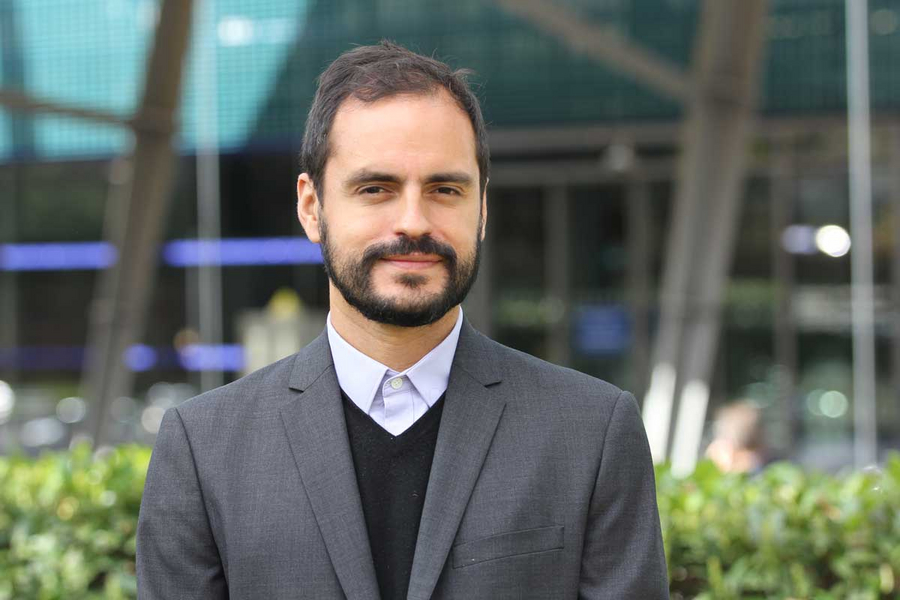
Daniel Colón-Ramos © MPI-CBG
In mid-February, Daniel Colón-Ramos, a McConnell Duberg Professor of Neuroscience and Cell Biology at Yale University School of Medicine, arrived at the MPI-CBG and the neighboring Center for Systems Biology (CSBD) for a six-month visit in the research lab of Anthony Hyman. Daniel came to Dresden via the ELBE Visiting Faculty Program of the CSBD. He also received a Humboldt Research Award for his stay in Dresden. Every year, the Alexander von Humboldt Foundation grants up to 100 Humboldt Research Awards to internationally leading researchers of all disciplines from abroad in recognition of their academic record to date. Award winners are invited to conduct a research project of their choice at a research institution in Germany in cooperation with specialist colleagues there.
Colón-Ramos was born and raised in Puerto Rico. He completed his PhD at Duke University and was a postdoctoral fellow at Stanford University. Now at Yale University, he and his lab are interested in how synapses are precisely assembled to build the neuronal architecture that underlies behavior. In 2019, he received an HFSP Program Grant Award together with Anthony Hyman to address glycolysis as a fundamental energy metabolic pathway. This joint project inspired Daniel to come to Dresden. He explains: “I came here because I have been increasingly interested in how physical principles can help us understand how synapses form during development and then how they are modified. The project that led me here was that we observed in our genetic studies that there were metabolic proteins localized all over the cell. We were able to observe that they come together to form a structure that we think is powering the synapses. We asked if these proteins could come together in a membraneless organelle through biophysical principles of phase separation. And how could phase separation help the enzymatic reactions of those proteins that are producing energy?” In addition to working on his collaborative project, Daniel Colón-Ramos wants to explore physics in the context of biology more during his stay. As director of the new Wu Tsai Institute at Yale University, he also wants to understand the ingredients that make an interdisciplinary institute work and how to encourage interactions.
In 2006, Daniel founded Ciencia Puerto Rico (CienciaPR), an organization to connect Puerto Rican scientists across the world with the mission to promote science in Puerto Rico but also in other Spanish-speaking communities. The project began as a database and an online community and has since grown into a nonprofit organization with over 15.000 registered scientists. Daniel says: “My passion, besides research, is to democratize access to science. Which is why I founded CienciaPR. Part of the purpose of the organization is to increase scientific literacy. We felt we needed to contextualize science. When I was growing up, our books for science classes came from the USA, translated into Spanish though, but all of the examples they used to contextualized science seemed irrelevant to my reality as a kid growing up in Puerto Rico. For instance, when exemplifying seed dispersal, they used the example of the maple tree. Growing up in Puerto Rico, I had never seen a maple tree. Or for instance, to introduce electricity, books used this beautiful phenomenon of rubbing a balloon in your hair; it seeing it stand up. Now, this will happen if you are in a temperate climate. It’s not going to happen in the tropics (because of humidity). All the examples were like that, out of context to my reality. And look, it is of course good to use examples from elsewhere and science is universal, but if to explain science you only use examples from elsewhere, if your role models don’t look like you, if the science is presented out of context, then you communicate the student or the general public: science might be interesting, but it is not for you. It is not relevant to you. You don’t belong to science. As a kid, you get the message that there are kids for which science works and there are kids like me for whom science doesn’t work. Experiences like that influenced me in wanting to make science more accessible. The organization I founded has grown, I now have a role as a board member, and it is gratifying to see how science can positively impact communities. When science has barriers that exclude certain demographics, humanity loses and communities that are underserved by science also lose.”
The ELBE Visiting Faculty Program at CSBD continuously offers funded opportunities for researchers working in the area of its mission. During their stay, visiting faculty closely interact with research groups at the CSBD, with labs at the MPI-CBG, and with the Max-Planck-Institute for the Physics of Complex Systems (MPI-PKS).